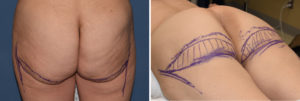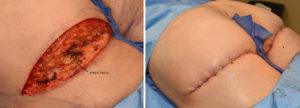Background: Buttock sagging, more formally known as buttock ptosis, occurs for a variety of reasons. Large amounts of weight loss is one well known cause of the lower buttocks to bottom out with volume deflation and the creation of a relative skin excess. Aging is another common cause and is particularly prone to occur in thin women who naturally have small buttock volumes. This is the result of the weakening of the infragluteal fold attachments creating a downward drift of the lower buttocks.
Of all the buttock contouring procedures, a lower buttock lift for buttock ptosis is the least frequently done. While not commonly performed it is actually the oldest buttock reshaping procedure, predating buttock implants and fat grafting to the buttocks. Because it leaves a scar to create its effects this is a concern to both patient and surgeon alike leading to its low incidence of use.
In the treatment of buttock ptosis, numerous treatments have been unsuccessfully tried. Liposuction is the most frequently attempted but it often only aggravates the problem since the lower buttock skin is not going to shrink down with volume removal. It usually creates an additional tissue roll or contributes more to the sagging one that already exists. Suture suspensions and even fat injections have been tried but neither one can remove the tissues excess or re-establish a stable infragluteal fold.



Highlights:
1) Buttock ptosis is when the lower portion of the buttocks either sags over the infragluteal fold or the entire infragluteal fold has dropped.
2) A lower buttock lift removes the over hanging tissues and recreates the infragluteal fold at a higher level.
3) The technique for creating the infragluteal fold is dermis-fascia-dermis suturing.
Dr. Barry Eppley
Indianapolis, Indiana





